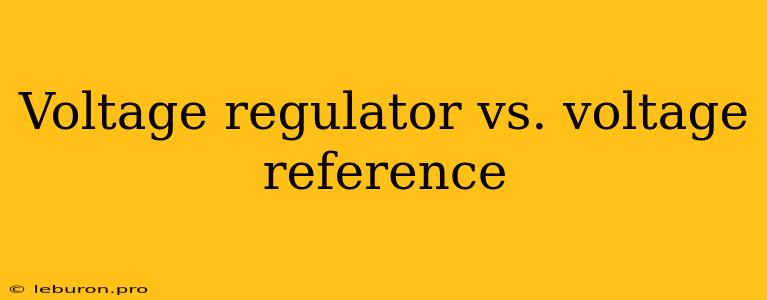In the realm of electronic circuits, maintaining stable and precise voltage levels is crucial for optimal performance and reliability. Two essential components that play a pivotal role in this regard are voltage regulators and voltage references. While both are vital for voltage management, they serve distinct functions and operate based on different principles. This article delves into the intricacies of voltage regulators and voltage references, exploring their key characteristics, applications, and the subtle yet crucial distinctions between them.
Understanding Voltage Regulators
A voltage regulator is an electronic circuit designed to maintain a constant output voltage regardless of variations in the input voltage or load current. Its primary function is to provide a regulated voltage output, ensuring that sensitive electronic components receive a stable and predictable power supply. Voltage regulators are essential in a wide range of applications, from simple power supplies to complex electronic systems.
Types of Voltage Regulators
Voltage regulators are categorized into two main types:
- Linear voltage regulators: These regulators employ a series pass transistor to regulate the output voltage. They are characterized by their simplicity, low noise, and excellent line and load regulation. However, linear regulators are relatively inefficient, as they dissipate excess power as heat.
- Switching voltage regulators: These regulators utilize switching techniques to regulate the output voltage. They are highly efficient, capable of handling significant power levels and are widely used in modern power supplies. However, switching regulators can generate electromagnetic interference (EMI) and are generally more complex than linear regulators.
Key Features of Voltage Regulators
- Output Voltage: The specific voltage output that the regulator is designed to provide.
- Input Voltage Range: The range of input voltages that the regulator can handle.
- Output Current: The maximum current that the regulator can supply to the load.
- Line Regulation: The change in output voltage for a given change in input voltage.
- Load Regulation: The change in output voltage for a given change in load current.
- Dropout Voltage: The minimum voltage difference between the input and output voltage that is required for the regulator to operate properly.
Delving into Voltage References
A voltage reference is a specialized electronic circuit that provides a highly stable and precise voltage output, typically independent of variations in input voltage, temperature, and load current. Voltage references are used as the primary voltage source for other circuits and are critical for ensuring accurate measurements and control in various applications.
Types of Voltage References
Voltage references can be classified based on their internal structure and operation:
- Bandgap references: These references exploit the inherent temperature dependency of a semiconductor's bandgap voltage to generate a stable and precise output voltage. They are known for their high accuracy and stability over a wide temperature range.
- Zener references: These references rely on the breakdown voltage characteristics of a Zener diode to provide a stable reference voltage. They are relatively simple and inexpensive but exhibit lower accuracy and stability compared to bandgap references.
Key Features of Voltage References
- Reference Voltage: The specific voltage output provided by the reference.
- Output Current: The maximum current that the reference can supply to the load.
- Temperature Coefficient: The change in reference voltage per degree Celsius of temperature change.
- Line Regulation: The change in reference voltage for a given change in input voltage.
- Load Regulation: The change in reference voltage for a given change in load current.
Comparing Voltage Regulators and Voltage References
While both voltage regulators and voltage references play crucial roles in voltage management, they are fundamentally distinct in their functions, operating principles, and characteristics.
| Feature | Voltage Regulator | Voltage Reference |
|---|---|---|
| Function | Regulate output voltage to a specific level | Provide a highly stable and accurate reference voltage |
| Input Voltage | Varies within a specified range | Often fixed or with a small range |
| Output Voltage | Regulated to a specific value | Highly stable and precise |
| Output Current | Can vary depending on the load | Typically limited to a small current |
| Line Regulation | Typically high to maintain stable output | Typically low to minimize voltage variation |
| Load Regulation | Typically high to maintain stable output | Typically low to minimize voltage variation |
| Stability | Less stable than voltage references | Extremely stable and accurate |
| Accuracy | Lower than voltage references | High precision and accuracy |
| Applications | Power supplies, electronic circuits | Measurement instruments, control systems, calibration equipment |
Conclusion
Voltage regulators and voltage references are indispensable components in electronic circuits, ensuring stable and precise voltage levels for optimal performance and reliability. While voltage regulators prioritize maintaining a constant output voltage, voltage references provide a highly accurate and stable reference voltage for other circuits. Understanding the nuances and distinctions between these two types of voltage control elements is essential for designing and troubleshooting electronic systems effectively.
